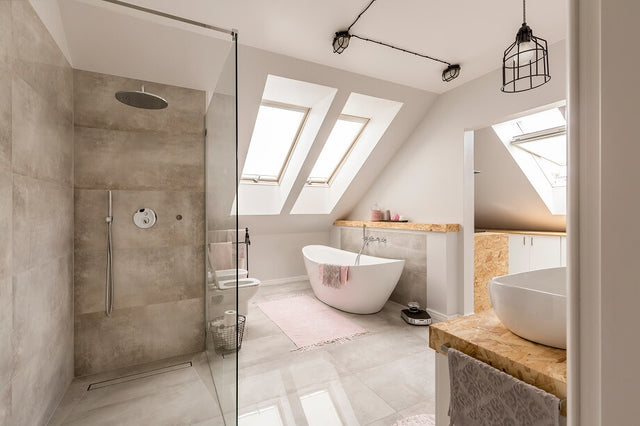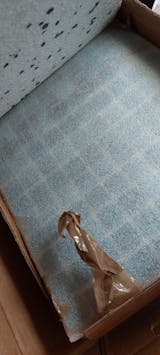How to lay tiles in the shower? Some tips for a perfect installation.
Do you dream of refreshing your bathroom and one of the main tasks on your list is to lay tiles in the shower? You've come to the right place! In our article, you will find invaluable tips and inspiring ideas that will help you in this process.
Laying tiles in the shower may seem complicated, but don't worry: with the right knowledge and planning, you can achieve amazing results.
How to lay tiles in a shower with a linear drain ?
A linear drain is a modern and elegant solution that not only facilitates water drainage but also gives a stylish look to the bathroom. At the beginning, it is worth paying attention to choosing the right linear drain, suitable for your needs and the style of the bathroom. There are many different models in various sizes and designs. Remember to choose a linear drain compatible with the thickness of the tiles you intend to use.
Once the linear drain is obtained, we begin to prepare the shower tray. Make sure the ground is properly leveled and has enough space to install the drain. If this requires modifications to the plumbing system, entrust this task to a professional.
Let's move on to the tile installation. It is important to properly design the layout, taking into account the linear drain. Usually, the best solution is to lay the tiles along the drain so that they create a harmonious line. You can also use contrasting tiles or decorative mosaics around the drain to highlight its presence.
When laying tiles around a linear drain, pay particular attention to the sealing of the connection. It is possible to use special sealing membranes or silicone to prevent water leaks. Make sure the tiles are even and that the drain is positioned correctly.
Once the tile installation is complete, do not forget to clean and properly maintain the linear drain. Regular removal of dirt and maintaining cleanliness ensure its efficient operation and long-term functionality.
How to lay tiles in a shower cabin ?
The installation of tiles in a shower cabin can be a bit more complicated than in other areas of the bathroom due to the presence of walls, corners, and the shape of the cabin.
Before laying the tiles, it is important to properly prepare the surface. Ensure that the walls of the cabin are clean, dry, and smooth. If any damage or irregularities are found, they must be repaired before starting the work.
So consider the possibility of choosing the right tiles for your shower. It is important to choose tiles that are moisture-resistant and easy to clean. You can choose bathroom tiles made from high-quality materials.
Before starting the tile installation, carefully plan the layout. You can use a traditional horizontal or vertical layout or choose more creative patterns like mosaics or decorative strips. Make sure the design matches the size of the tiles and the proportions of the shower.
Once you have a laying plan, you can start applying the tile adhesive to the wall. Use a suitable waterproof adhesive and spread it evenly on the wall surface using a notched trowel. Then stick the tiles, trying to maintain the same distance between them.
Remember to maintain an expansion gap between the tiles, which will allow the materials to expand and contract naturally due to temperature and humidity fluctuations. Use spacers to ensure an even distance between the tiles and allow for easier grout application.
Once the tiling is finished, let them rest for a few hours so that the adhesive can dry properly. Then start grouting. Choose the right grout color that will match your design and tiles. Apply the grout with a spatula, trying to fill the gaps between the tiles.
After grouting, remove excess grout with a sponge or a damp cloth. Allow the mortar to dry according to the manufacturer's instructions. Once the joints are dry, you can begin the final cleaning and polishing of the tiles to make them shiny and clean.
Remember that every shower is unique, so adapt these tips to your individual needs. By keeping these recommendations in mind and following a careful plan, you will be able to lay the tiles of your shower by yourself and enjoy a beautiful and functional shower space for many years to come.
Tile installation shower box and types of tiles
The installation of tiles in the shower is not only a matter of functionality but also of aesthetics. Choosing the right tiles is of great importance for the final appearance of your bathroom. Among the different types of tiles you can use in your shower, you might consider mosaic tiles, rectangular, and square tiles.
Mosaic tiles are extremely popular in bathrooms. They are small in size and consist of smaller pieces, creating attractive patterns and textures. Mosaics are very versatile and can add character and originality to your bathroom. They can be made from various materials, such as ceramic, glass, or stone, which offers a wide range of design possibilities. Mosaic tiles are perfect for creating decorative accents in the shower area or on the walls, adding definition and personality.
Rectangular and square tiles are classic choices that are always appreciated. Rectangular tiles with 1:2 proportions, also known as metropolitan tiles, are elegant and trendy. They add a classic character and are suitable for various bathroom layouts. They can be arranged in the traditional horizontal or vertical layout, or more modern patterns can be used. Square tiles are universal and easy to install. They are suitable for both minimalist and modern interiors as well as more traditional styles. You can choose from a variety of sizes, from smaller squares to larger slabs, based on your preferences and the dimensions of your space.
Don't forget that in addition to the type of tile, the color, texture, and pattern are also important for the final effect. You can experiment with different combinations of tiles, creating interesting mosaics, geometric patterns, or soft shades. However, remember to maintain visual consistency and match it with the rest of the bathroom layout.
How to lay tiles under the shower: the most common problems
During the installation of tiles in the shower, even the most experienced DIYers may encounter some problems. One of these is the irregularity of the surface. If the substrate beneath the tiles is not even, this could cause difficulties in correctly laying the tiles. In such a situation, it is important to prepare the support by leveling it, removing the irregularities, and leveling the surface. It is possible to use a self-leveling compound or appropriate tools to level the surface.
Another common challenge is laying tiles around difficult areas, such as a linear drain or corners. In these cases, it is worth consulting a specialist or using guides and tutorials that can help overcome these difficulties. You can also use strips and special profiles that will facilitate the laying of tiles in difficult spots.
The last issue to mention is the inadequate protection of tiles from water. If the grouts are not applied correctly or the tiles are not firmly glued, water leaks can occur, leading to the formation of mold or damage to the substrate. Make sure to use the right sealing materials and techniques, such as waterproof adhesives and mortars, to prevent such problems.
Bathroom renovation: valuable information
How laying the shower tiles is not the only element to consider when renovating the bathroom. It is worth remembering to ensure high-quality materials, as this largely determines how long you will be able to enjoy the bathroom you desire. A key element to consider is the floor tiles. It is important to choose the right tiles that are durable and abrasion-resistant to withstand daily use. It is also worth paying attention to the fact that some floor tiles have anti-slip properties, which is particularly important in the bathroom, where the floor may be wet. When choosing floor tiles, it is necessary to also take into account their shape, size, color, and design to match the style and layout of the entire bathroom.








0 Comments
There are no comments for this article. Be the first one to leave a message!